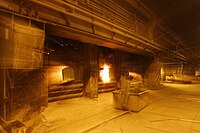Reverberatory furnace

Imagine you have a toy kitchen with a stove where you can cook food. Now, let's imagine you want to cook something big like a turkey. But the stove in your toy kitchen is too small. So, what do you do? You go outside and build a big cooking fire, and then put your turkey on a spit in front of the fire.
In a similar way, a reverberatory furnace is a really big oven used to melt metal. It's too big to fit in a regular kitchen or workshop. Instead, it's built outside in a factory or refinery. The furnace has a big chamber (like the one in your toy kitchen) where you put the metal to be heated up. But the chamber is also surrounded by a special area called a "reverb chamber" (short for reverberatory) that's like the area where you would put your turkey spit.
This reverb chamber is actually a heating area that uses fire, gas or electricity to heat up the air around the furnace chamber, creating very high temperatures. When the metal inside the furnace is hot enough, it starts to melt, and the heat from the metal mixes with the hot air in the reverb chamber. This creates a lot more heat and energy, making the metal even hotter and allowing it to melt faster. This helps to make the process of melting and refining metals easier, faster and more efficient, which is important for industries like metalworking and mining.
So, in summary, a reverberatory furnace is a big, outdoor oven used by industries to melt and refine metal. It has an extra heating area around the furnace chamber that helps to create more heat and energy, making the process of melting metal faster and more efficient.
In a similar way, a reverberatory furnace is a really big oven used to melt metal. It's too big to fit in a regular kitchen or workshop. Instead, it's built outside in a factory or refinery. The furnace has a big chamber (like the one in your toy kitchen) where you put the metal to be heated up. But the chamber is also surrounded by a special area called a "reverb chamber" (short for reverberatory) that's like the area where you would put your turkey spit.
This reverb chamber is actually a heating area that uses fire, gas or electricity to heat up the air around the furnace chamber, creating very high temperatures. When the metal inside the furnace is hot enough, it starts to melt, and the heat from the metal mixes with the hot air in the reverb chamber. This creates a lot more heat and energy, making the metal even hotter and allowing it to melt faster. This helps to make the process of melting and refining metals easier, faster and more efficient, which is important for industries like metalworking and mining.
So, in summary, a reverberatory furnace is a big, outdoor oven used by industries to melt and refine metal. It has an extra heating area around the furnace chamber that helps to create more heat and energy, making the process of melting metal faster and more efficient.
Related topics others have asked about:
